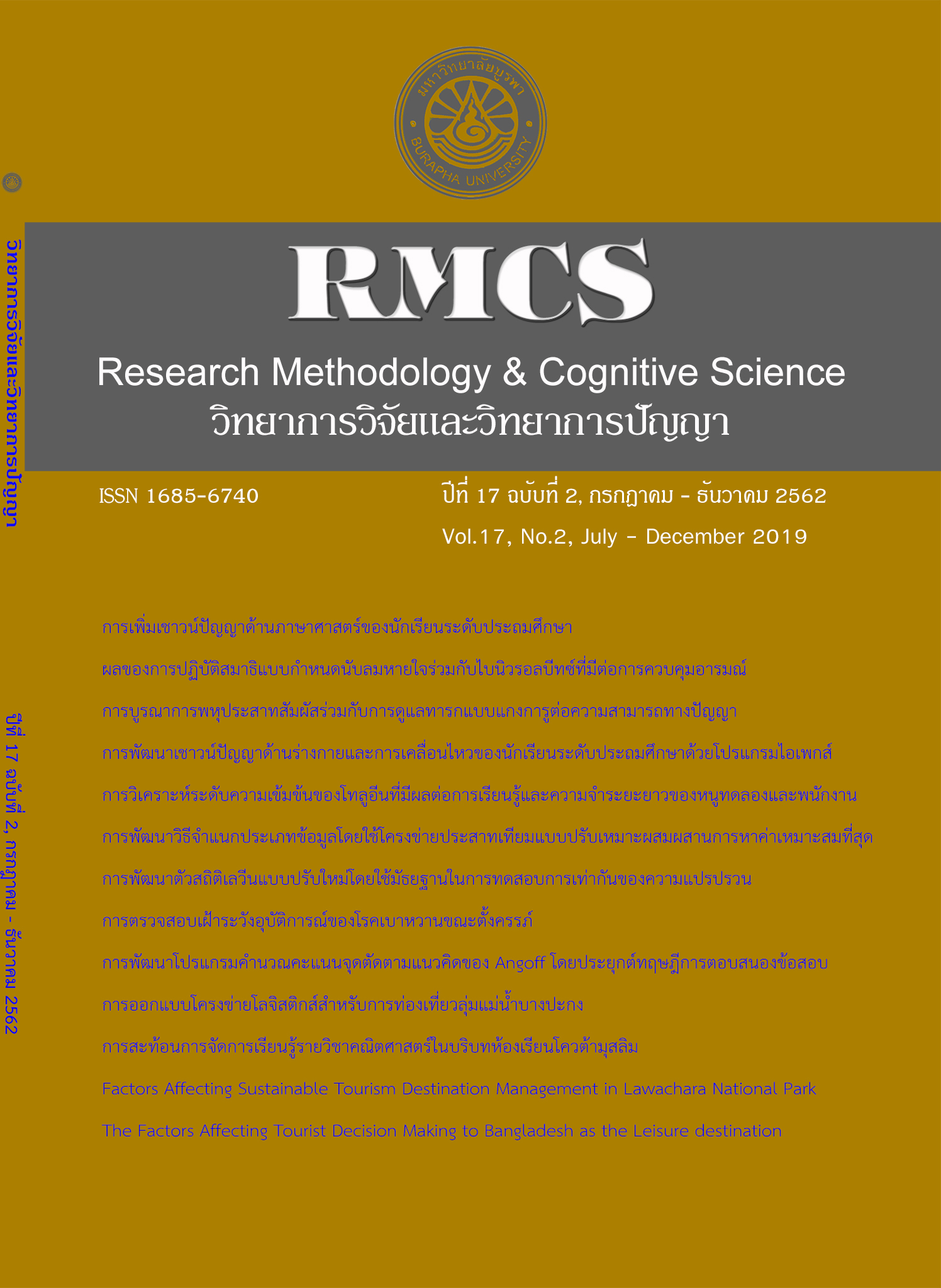Enhancing Linguistic Intelligence Among Primary School Student Using Language Comprehension Training Program: EEG Study
Main Article Content
Abstract
This research aimed to create a language comprehension training program create a linguistic intelligence test and to study the results of the language comprehension training program. The study was comparing the differences in the EEG from making linguistic intelligence test before and after training with language comprehension training programs. The final study were testing of interactions between gender and general intelligence that affected on the EEG post-training with language comprehension training program. There are 81 students in sample group divide into 4 groups (19-21 per group) using 2x2 Factorial Pretest and Posttest Design (Between Subjects). The subjects were volunteers to participate in the research. Collected data from test activities via computer screen with linguistic intelligence test and EEG measurement. Statistics used are t-test dependent Two-way ANOVA and effect size.
The results of the research showed that the language comprehension training program could increase linguistic intelligence. In the overall the sample group had the absolute EEG after training was higher than before training. The EEG of boys were higher than girls. The EEG of low general intelligence groups were higher than high general intelligence groups. There were interaction between gender and general intelligence on the Gamma brain waves at position F3.
Article Details
References
Bonhage, C. E., Meyer, L., Gruber, T., Friederici, A. D. & Mueller, J. L. (2017). Oscillatory EEG dynamics underlying automatic chunking during sentence processing. NeuroImage, 152(1), 647-657.
Budrina, E. G. (2017). Gender Characteristics of Intelligence and academic achievement of younger school children. Procedia–Social and Behavioral Sciences, 237(1), 1390-1397.
Castejon, J. L., Perez, A. M., & Gilar, R. (2010). Confirmatory factor analysis of project spectrum activities. A second-order g factor or multiple intelligences?. Intelligence, 38(5), 481-496.
Cavojova, V., & Mikuskova, E. B. (2015). Does intelligence predict academic achievement? Two case studies. Procedia-Social and Behavioral Sciences, 174(1), 3462-3469.
Deary, I. J., Strand, S., Smith, P., & Fernandes, C. (2007). Intelligence and educational achievement. Intelligence, 35(1), 13-21.
Edmonds, W. A., & Kennedy, T. D. (2017). An applied guide to research designs: quantitative, qualitative, and mixed methods. (2nd ed.). Thounsand Oaks: SAGE Publications.
Gagol, A., Magnuski, M., Kroczek, B., Kałamała, P., Ociepka, M., Santarnecchi, E., & Chuderski, A. (2018). Delta-gamma coupling as a potential neurophysiological mechanism of fluid intelligence. Intelligence, 66, 54-63.
Gardner, H. (2011). Frames of mind: The theory of multiple intelligences. New York: Basic Books.
Kang, J. S., Ojha, A.,Lee, G. & Lee, M. (2017). Difference in brain activation patterns of individuals with high and low intelligence in linguistic and visuo-spatial tasks: An EEG study. Intelligence, 61(1), 47-55.
Kartiah, S. R., Rahman M. A., Rahman A. Q., & Jabu B. (2014). The portrayal of multiple intelligence theory in English teaching strategy for Indonesian secondary school. Journal of Language Teaching and Research, 5(5), 1052-1061.
Kykalova, M., & Vasilyeva, E. A. (2015). On the problem of categorizing students based on their cognitive styles and teaching strategies. Procedia–Social and Behavioral Science, 176(1), 578-587.
Mayer, R. E. (2003). The promise of multimedia learning: Using the same instructional design methods across different media. Learning and Instruction, 13(2), 125-139.
Mayer, R. E. (2009). Multimedia learning (2nd ed.). Cambridge: Cambridge university press.
Mcglynn, B. K., & Kozlowski, J. (2017). Going from macro to micro in the classroom. Science for All, 66-68.
Oei, A. C., & Patterson, M. D. (2014). Playing a puzzle video game with changing requirements improves executive functions. Computers in Human Behavior, 37(1), 216-228.
Parviz, M., & Gorjian, B. (2014). The role of iranian students’ gender in using email writing linguistic features. Procedia-Social and Behavioral Sciences, 98(1), 1417-1421.
Pascual-Marqui, R. D. (2002). Standardized Low-Resolution Brain Electromagnetic Tomography (sLORETA): Technical Details. Methods and Findings in Experimental Clinical Pharmarcology, 24(1), 5-12.
Penolazzi, B., Angrilli, A. & Job, R. (2009). Gamma EEG activity induced by semantic violation during sentence reading. Neuroscience Letters, 465(1), 74-78.
Prensky, M. (2007). Digital game-based learning. New York: McGraw-Hill.
Raven, J. (1986). Manual for Raven’s Progressive Matrices and Vocabulary Scales. Research Supplement No.3. London: Lewis & Co, Ltd.
Sajjadi, P., Vlieghe, J., & De Troyer, O. (2016). Relation between multiple intelligence and game preferences: An evidence-based approach. Proceedings of The 10th European Conference on Games Based Learning, 565-574.
Shearer, C. B., & Karanian, J. M. (2017). The neuroscience of intelligence: Empirical support for the theory of multiple intelligences?. Trends in Neuroscience and Education, 6(1), 211-223.
Sitzmann, T. (2011). A meta-analytic examination of the instruction effectiveness of computer-based simulation games. Personnel Psychology, 64(1), 489-528.
Soares, D. L., Lemos, G.C., Primi, R. & Almeida, L. S. (2015). The relationship between intelligence and academic achievement through out middle school: The role of students' prior academic performance. Learning and Individual Differences, 41(1), 73-78.
Storek, J., & Furnham, A. (2012). Gender and gender role differences in domain-Masculine Intelligence and Beliefs about Intelligence: A study with Mensa UK members. Personality and Individual Differences, 53(7), 890-895.
Suh, Y. A., & Yim, M. (2018). “High risk non-initiating insider” identification based on EEG analysis for enhancing nuclear security. Annals of Nuclear Energy, 113(1), 308-318.
Systad, S., Bjornvold, M., Markhus, R., & Lyster, S. H. (2017). Watch the language! Language and linguistic–cognitive abilities in children with nocturnal epileptiform activity. Epilepsy & Behavior, 66(1), 10-18.
Tarbetsky, A. L., Collie, R. J., & Martin, A. J. (2016). The role of implicit theories of intelligence and ability in predicting achievement for indigenous (Aboriginal) Australian students. Contemporary Educational Psychology, 47(1), 61-71.
Trans Cranial Technologies. (2012). Cortical Functions Reference. Wanchai: Trans Cranial Technologies ltd.
Verhoeven, L., & Leeuwe, J. (2011). Role of gender and linguistic diversity in word decoding development. Learning and Individual Differences, 21(1), 359-367.
Zhong, N., Khurana, V., Kumar, P., Saini, R., & Roy, P. P. (2018). EEG based word familiarity using features and frequency bands combination. Cognitive Systems Research, 49(1), 33-48.
Zulkiply, N., Adruce, S. A. Z., Ghani, K. A., & Chen, P. L. (2008). Gender and educational stream differences in memory retention for verbal and non-verbal tasks. The International Journal of Learning, 15(3), 221-225.

